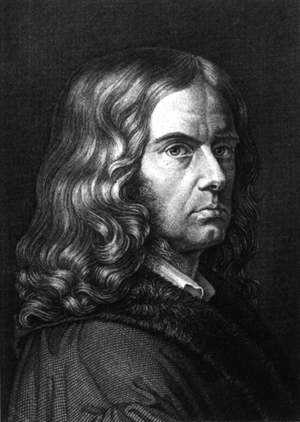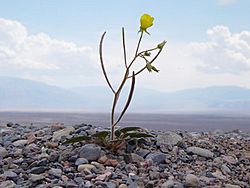Adelbert von Chamisso facts for kids
Quick facts for kids
Adelbert von Chamisso
|
|
|---|---|
 |
|
| Born |
Louis Charles Adélaïde de Chamissot
30 January 1781 Ante, Champagne, Kingdom of France
|
| Died | 21 August 1838 (aged 57) Berlin, Province of Brandenburg, Kingdom of Prussia
|
| Nationality | Prussian |
| Occupation | Poet and botanist |
| Known for | Peter Schlemihl, the man who sold his shadow, Views and Remarks on a Voyage of Discovery, Description of a Voyage Round the World, description of many trees of Mexico |
| Spouse(s) | Antonie Piaste |
| Parents |
|
| Awards | Prussian Academy of Sciences |
| Scientific career | |
| Author abbrev. (botany) | Cham. |
Adelbert von Chamisso (born January 30, 1781 – died August 21, 1838) was a famous German poet and botanist. He is best known for his story Peter Schlemihl, about a man who sells his shadow. In French, he was often called Adelbert de Chamisso de Boncourt, named after his family's home.
Chamisso's family had to leave France during the French Revolution. They moved to Berlin, where Chamisso joined the Prussian army. He also started studying natural science. Even though his life was tough, with wars and losing his parents, he became a respected poet and scientist.
Later, Chamisso focused on studying plants. In 1815, he joined a Russian science trip around the world. On this trip, he discovered and named many new plant species. When he returned, he became the head of the botanical gardens in Berlin. He also joined the Academy of Sciences. His work helped describe important trees in Mexico. Many plants were even named after him!
When he was older, Chamisso returned to writing poetry. His poems, especially "Frauenliebe und -leben," were so popular that many composers turned them into songs.
Contents
Early Life and Military Career
Adelbert von Chamisso was born Louis Charles Adélaïde de Chamissot. His family lived at the château (a large country house) of Boncourt in France. In 1790, his family had to flee France because of the French Revolution. They moved around Europe before settling in Berlin.
In Berlin, young Chamisso became a page (an attendant) to the queen of Prussia. In 1798, he joined the Prussian army as an ensign. This was the start of his military career.
Chamisso did not have much formal schooling. But while in the army in Berlin, he spent three years studying natural science. In 1803, he helped start a literary magazine called Berliner Musenalmanach. This magazine published his first poems. The magazine did not last long, but it helped him become known as a promising poet.
In 1805, Chamisso's army unit went to Hamelin. They had to surrender to the French army the next year. After this, Chamisso went to France, but both his parents had died. He returned to Berlin in 1807 and left the Prussian army in 1808. For a few years, he felt lost and had no job.
Journey and Famous Story
In 1810, a family friend helped Chamisso get a teaching job in France. But instead, he joined a group of thinkers around Madame de Staël. He followed her to Coppet in Switzerland. There, he spent almost two years focusing on botanical research.
In 1812, he returned to Berlin and continued his science studies. In the summer of 1813, he wrote his most famous story, Peter Schlemihl, the man who sold his shadow. This story has been translated into many languages. He wrote it to cheer himself up and to entertain the children of his friend, Julius Eduard Hitzig.
World Voyage and Botanical Discoveries
In 1815, Chamisso was chosen to be the botanist on a Russian ship called the Rurik. This ship was going on a scientific trip around the world. The trip was paid for by Count Nikolay Rumyantsev. Otto von Kotzebue was the captain.
Chamisso's journal from this trip (called Tagebuch, published in 1821) tells a fascinating story of their journey. They explored the Pacific Ocean and the Bering Sea. During this trip, Chamisso found and described many new plant species. Some of these were found in what is now the San Francisco Bay Area.
For example, the California poppy, Eschscholzia californica, was named after his friend Johann Friedrich von Eschscholtz. In return, Eschscholtz named a group of plants, the genus Camissonia, after Chamisso.
When he returned in 1818, Chamisso became the head of the botanical gardens in Berlin. He was also chosen to be a member of the Prussian Academy of Sciences. In 1819, he married Antonie Piaste. He also became an important member of a literary group called the Serapion Brethren.
Later Works and Legacy
In 1827, Chamisso published Views and Remarks on a Voyage of Discovery. He also wrote Description of a Voyage Round the World. These books showed how careful and hardworking he was. His last scientific work was about the Hawaiian language.
Chamisso's travels and science work kept him from writing poetry for a while. It was not until he was 48 that he returned to literature. In 1829, he helped publish the Deutscher Musenalmanach. Many of his later poems were published there.
Chamisso passed away in Berlin when he was 57 years old. His grave is in a cemetery in Berlin-Kreuzberg.
Botanical Work and Plant Names
Chamisso is mostly remembered for his work as a botanist. His most important work was describing many important trees of Mexico. He did this with Diederich Franz Leonhard von Schlechtendal in 1830–1831.
His book Übersicht der nutzbarsten und schädlichsten Gewächse in Norddeutschland (Review of the Most Useful and the Most Noxious Plants of North Germany) from 1829 is also highly valued. In 1824, he became a member of the Regensburg Botanical Society.
Many plants were named in his honor. These include the plant groups Chamissoa and Camissonia, as well as many individual plant species.
Literary Works
Chamisso's first writings, including some poems in French, showed he was still learning his new language, German. Between 1801 and 1804, he worked closely with other writers and edited their journal.
As a poet, Chamisso is highly regarded. His collection of lyrical poems called Frauenliebe und -leben (1830) is very famous. It has been set to music by composers like Robert Schumann and Carl Loewe.
Other notable poems include Schloss Boncourt and Salas y Gomez. Chamisso often wrote about serious or sad topics. Even in his lighter poems, there was often a hint of sadness or humor. He was good at showing strong feelings in his poems. For example, Die Löwenbraut shows his powerful and unique style.
Legacy
Otto von Kotzebue named Chamisso Island after him. A type of Chilean snake, Philodryas chamissonis, was also named to honor Chamisso.
See Also
 In Spanish: Adelbert von Chamisso para niños
In Spanish: Adelbert von Chamisso para niños
- Adelbert-von-Chamisso-Award
- Chamisso Island
- Chamisso Wilderness
- European and American voyages of scientific exploration
- List of plants of Caatinga vegetation of Brazil
- List of plants of Cerrado vegetation of Brazil



